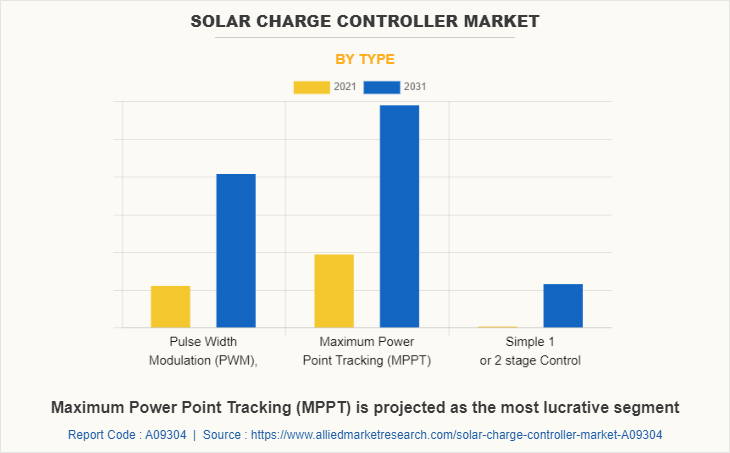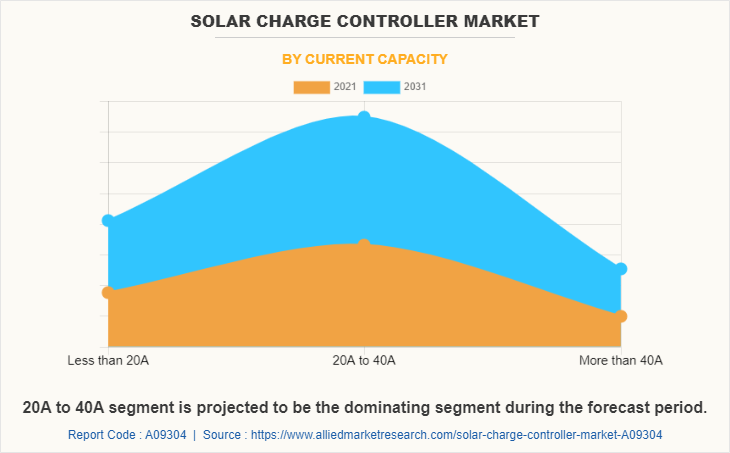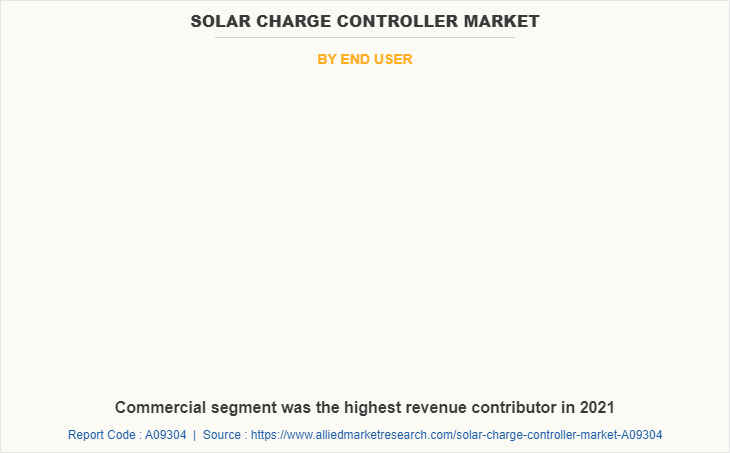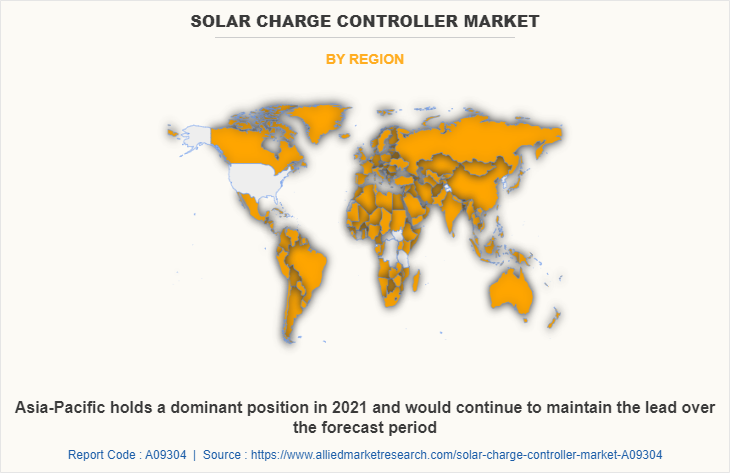Solar Charge Controller Market Research, 2031
The global solar charge controller market size was valued at $1.8 billion in 2021, and is projected to reach $3.4 billion by 2031, growing at a CAGR of 6.6% from 2022 to 2031. The solar charge controller controls the flow of current and voltage from solar panels to the linked battery, preventing the battery from being overcharged or discharged. Solar charge controllers are primarily utilized in off-grid solar panels to control the energy flow into batteries. Most commercially accessible solar charge controllers for PV applications use a switched series regulator to control the charging current. A solar charge controller is a solar-powered voltage and current regulator. They are used to manage power input from PV arrays in off-grid and hybrid off-grid applications so that the best power output is given to run electrical loads and charge batteries. Solar charge converters are also known as solar charge regulators.
Lockdown imposed due to the outbreak of COVID-19 pandemic resulted in temporary ban on import & export and manufacturing & processing activities across various industries, which decreased the demand for solar power components including panels, batteries, controllers, and others. In addition, halt in building and construction of solar energy power plants, owing to unavailability of workers and increase in demand–supply gap hampered the solar charge controller market growth during the pandemic period. This declined the market growth in second, third, and fourth quarters of 2020. However, the solar charge controller market recovered by the 2nd quarter of 2021, as COVID-19 vaccination began in various economies across the globe, which improved the global economy.
The rapid increase of solar panel installations, increase in variety of rooftop operations in remote areas, and rise in electronic infrastructure for solar power technologies all contribute to the market growth. The solar charge controller market is predicted to rise owing to the rise in power consumption from data centers and communication base stations, as well as increased penetration of solar PV modules in hospitals, hotels, and corporate offices. However, high initial installation cost of solar battery and disadvantages associated with solar charge controllers are expected to hamper the solar charge controller market growth in the coming years. On the contrary, government initiatives & investments toward different solar infrastructure projects in energy, railways, and real estate are expected to create opportunities for key players operating in the market during the forecast period.

The solar charge controller market is segmented into Type, Current Capacity and End User. Depending on type, the market is bifurcated into pulse width modulation (PWM) charge controller, maximum power point tracking (MPPT) charge controller, and simple 1 or 2 stage controls. On the basis of current capacity, it is categorized into less than 20A, 20A to 40A, and more than 40A. By end user, it is divided into solar home stations, commercial & utility, and industrial. Region-wise, the market is analyzed across North America, Europe, Asia-Pacific, and LAMEA.
The global market covers in-depth information about the major solar charge controller industry participants. Some of the major players in the market include, Airkom Group, Schneider Electric, Sollatek, Wenzhou Xihe Electric Co., Ltd., Delta Electronics, Inc., KATEK Memmingen GmbH, Victron Energy, Sunforge LLC, Phocos, and Apollo Solar.
The key players have adopted numerous strategies, such as product launch, partnership, and others, to stay competitive in the solar charge controller market.
For instance, in October, 2020, Schneider Electric launched Conext MPPT 100 high-power solar charge controller, which purportedly ramps up charging power by 25% as compared to its predecessor, the MPPT 80. The product is designed to operate at 600 V, including the temperature correction factor, which drives a reduction in balance-of-system costs. This strategy enhanced the product portfolio of the company.
Other players operating in the value chain of the global solar charge controller market are Easy Photovoltaic Pvt Ltd, Outback Power Technologies, Xantrex Technologies, Genasun, Su-Kam Power Systems, Arise India, Beijing Epsolar Technology Co., Ltd, and others.

Depending on type, the maximum power point tracking (MPPT) segment held the highest solar charge controller market share of around 43.3% in 2021, and is expected to maintain its dominance during the solar charge controller market forecast period. This is attributed to rise in deployment of solar power generation infrastructure across the globe. In addition, MPPT solar charge controller extract maximum power from solar panels and high efficiency & performance of MPPT as compared to PWM solar charge controllers, which are expected to drive the growth of the market during the forecast period.

On the basis of current capacity, the 20A to 40A segment holds the largest share, in terms of revenue, and is expected to maintain its dominance during the forecast period. This growth is attributed to rise in demand for solar charge controllers with current capacity 20A to 40A from off grid cabinets, homes, caravans, telecommunications, and remote solar power generation sites. In addition, rapid investment towards solar power generation is anticipated to fuel the growth of the solar charge controller market in the coming years.

On the basis of end user, the commercial segment holds the largest share, in terms of revenue, and is expected to maintain its dominance during the forecast period. This growth is attributed to rise in demand for solar charge controllers from commercial applications for power consumption in data centers, communication base stations, hospitals, restaurants, corporate offices, and others. In addition, the usage of solar energy applications in the commercial sector is the quickest solution to fight energy deficit and thereby, is expected to fuel the demand for solar charge controllers during the forecast period.

Region-wise, the market is analyzed across four major regions, such as North America, Europe, Asia-Pacific, and LAMEA. Asia-Pacific garnered the dominant share in 2020, and is anticipated to maintain this dominance in the solar charge controller market trend during the forecast period. This is attributed to the presence of key players and huge consumer base in the region.
In addition, rapid growth of the off-grid power generation, rise in demand for power in remote operations, rise in awareness and R&D towards battery safety, and others are the key factors driving the growth of the solar charge controller market in the Asia-Pacific region in the coming years.
The solar charge controller market is analyzed and estimated in accordance with the impacts of drivers, restraints, and opportunities. The period studied in this report is 2021–2031. The report includes the study of the solar charge controller market with respect to the growth prospects and restraints based on regional analysis. The study includes Porter’s five forces analysis of the industry to determine the impact of suppliers, competitors, new entrants, substitutes, and buyers on the market growth.
Key Benefits For Stakeholders
- This report provides a quantitative analysis of the market segments, current trends, estimations, and dynamics of the solar charge controller market analysis from 2021 to 2031 to identify the prevailing solar charge controller market opportunities.
- The market research is offered along with information related to key drivers, restraints, and opportunities.
- Porter's five forces analysis highlights the potency of buyers and suppliers to enable stakeholders make profit-oriented business decisions and strengthen their supplier-buyer network.
- In-depth analysis of the solar charge controller market segmentation assists to determine the prevailing market opportunities.
- Major countries in each region are mapped according to their revenue contribution to the global market.
- Market player positioning facilitates benchmarking and provides a clear understanding of the present position of the market players.
- The report includes the analysis of the regional as well as global solar charge controller market trends, key players, market segments, application areas, and market growth strategies.
Solar Charge Controller Market Report Highlights
| Aspects | Details |
| By Type |
|
| By Current Capacity |
|
| By End User |
|
| By Region |
|
| Key Market Players | Phocas, Xantrex Technologies, Shenzhen Shuori New Energy Technology Co. Ltd., Outback Power Inc., Gena Sun LLC, Studer Innotec, Steca Electronic GmbH, Microtek, Simplex America Inc., Luminous Power Technologies Pt. Ltd. |
Analyst Review
The demand for solar charge controllers is fueled by increase in construction renovation activities, increase in cross-country power transmission & distribution networks, replacement of old power units, rapid growth in electric vehicle sector, and mainstream adoption of renewable energy generation, and these are expected to drive the solar charge controller market growth during the forecast period.
Rise in demand for solar charge controllers from solar power generation applications in residential, commercial & utility, and industrial is expected to fuel the market growth in the coming years. In addition, rapid growth of the solar panel installations and increase in rooftop solar installations across the globe owing to rise in government initiatives and support is anticipated to drive the growth of the market during the forecast period. However, high cost associated with MPPT solar charge controller as compared to PWM-based controllers and high cost associated with solar battery installation are key factors hampering the market growth during the forecast period. On the contrary, rapid investment towards EV charging infrastructure across the globe is anticipated to drive the market growth in the coming years.
Among the analyzed regions, Asia-Pacific is expected to account for the highest revenue in the market during the forecast period, followed by North America, Europe, and LAMEA. Asia-Pacific accounted for 41.4% of the total global solar charge controller market share in 2021, and is expected to maintain its dominance during the forecast period.
Growing interest towards renewable energy storage solutions and rapid growth of solar sector are the upcoming trends of solar charge controller market in the world.
Asia-Pacific is the largest regional market for solar charge controller market.
Commercial users are the leading users in the solar charge controller market.
Airkom Group, Schneider Electric, Sollatek, Wenzhou Xihe Electric Co., Ltd., Delta Electronics, Inc., KATEK Memmingen GmbH, Victron Energy, Sunforge LLC, Phocos, and Apollo Solar are the top companies to hold the market share in solar charge controller market.
The global solar charge controller market was valued at $1.8 billion in 2021, and is projected to reach $3.4 billion by 2031, growing at a CAGR of 6.6% from 2022 to 2031.
Loading Table Of Content...



